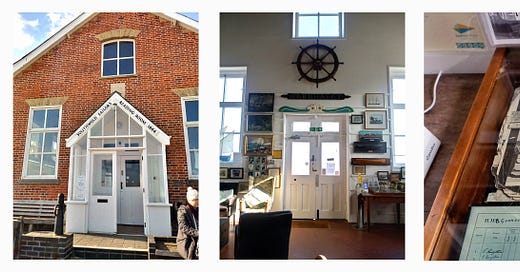Sailors' Reading Room, Southwold
'Princip Lights the Fuse!' — WG Sebald spent a couple of nights in Southwold on the Suffolk coast, having walked south from Lowestoft and Benacre, as described in ‘The Rings of Saturn’, and one evening he visits the Sailors’ Reading Room on the seafront. It’s one of my favourite sections of the book, since the Reading Room is a fantastic old-style museum, packed from floor to ceiling with maritime artifacts & memorabilia of the Suffolk coast, and one that mercifully has not been smartened up too much, retaining much of its old-world charm. I remember visiting it as a child, and marvelling at the ships’ models, so when I returned recently it had that strange sense of unchanging familiarity. Let Sebald describe it:
"I sought the familiarity of the streets and soon found myself outside the Sailors’ Reading Room, a charitable establishment housed in a small building above the promenade, which nowadays, sailors being a dying breed, serves principally as a kind of maritime museum, where all manner of things connected with the sea and seafaring life are kept and collected. On the walls hang barometers and navigational instruments, figureheads, and models of ships in glass cases and in bottles. On the tables are harbourmasters’ registers, log books, treatises on sailing, various nautical periodicals, and several volumes with colour plates which show legendary clippers and ocean-going steamers."
I visited the Reading Room hoping to find the book about WWI which is featured in chapter IV of The Rings, an iconic section of the book about war and showing the blood-spattered uniform of Archduke Ferdinand, whose assassination triggered the start of that 'Great War'. I was surprised to see the book is on display in a case by the door, along with a photo of Sebald, a short biographical text, and a copy of the log book opened at the page that Sebald refers to in his text.
"I noticed lying to one side on the table a thick, tattered tome that I had not seen before on my visits to the Reading Room. It turned out to be a photographic history of the First World War, compiled and published in 1933 by the Daily Express, to mark the past tragedy, and perhaps as a warning of another approaching…
The facing page shows the tunic of Archduke Franz Ferdinand’s uniform, holed by bullets and soaked with blood, which must have been photographed for the press after being stripped from the body of the heir to the throne and transferred by rail to the capital of the empire, where it can be viewed to this day, together with his feather bushed hat and trousers, in a black-framed reliquary in the army museum."
Apart from the Sebald links and my search for the book, the Reading Room provides a fascinating dip into a past that has largely vanished, since the fishermen and seamen commemorated here are all gone, and their lifestyle will likely never be recreated. I was alone in the place for half an hour, poring over the artifacts & photo captions, with just the constant loud ticking of the wall clock above the fireplace, the muffled voices passing by & shrieks of gulls outside, and the relentless waves of the North Sea breaking on the shore below the cliff.
After visiting the Reading Room, I managed to get my own copy of the book ('The First World War: A Photographic History', by Laurence Stallings Published 1933). It contains several very graphic images from the trenches, of burnt out and destroyed buildings, as well as a few photos from the Russian side, including one of Bolsheviks poring over the Romanov crown jewels. Sebald writes about the book contents, and picks up on the captions:
“There are illustrations of all conceivable forms of violent death, from the shooting down of a single aviation pioneer over the Somme estuary to the mass slaughter in the swamps of Galicia,...
The titles are almost without exception bitterly ironic – When Cities Deck Their Streets for War! This was a Forest! This was a Man!”
Although these images were taken over 100 years ago, the horrific scenes they depict have been repeated many times since, in many places across the world, and sadly continue to the present day.





